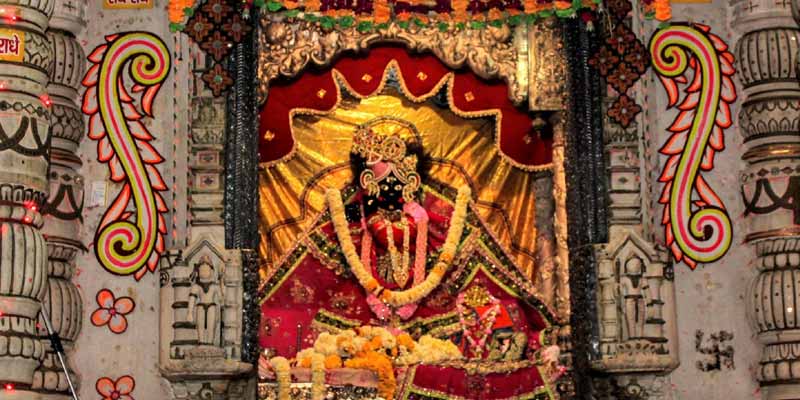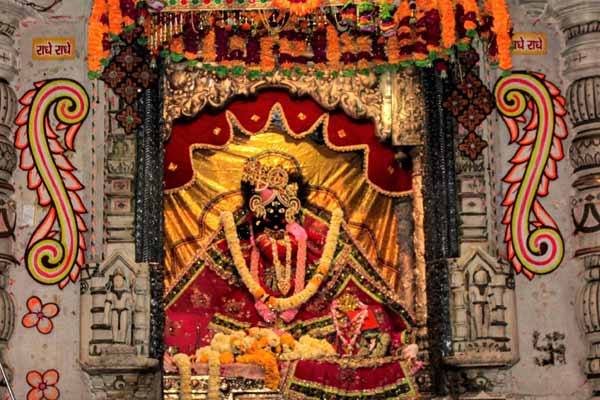Banke Bihari Temple, situated in Vrindavan, India, is an esteemed Hindu shrine dedicated to Lord Krishna. Renowned for its divine aura and spiritual significance, this temple attracts devotees and tourists from around the world.
Constructed in the 1860s, the temple’s architecture showcases intricate designs and vibrant colors, reflecting traditional Rajasthani style. Inside, the main sanctum houses a captivating idol of Lord Krishna in his child form, known as Banke Bihari or “bent in three places.” The idol’s charm and unique appearance captivate devotees, who believe that gazing into the eyes of Banke Bihari can bring immense peace and fulfillment, Vrindavan Tour Packages.
Devotional hymns, known as bhajans and kirtans, fill the air as devotees chant and sing in praise of Lord Krishna, creating an atmosphere brimming with spirituality and devotion. The temple celebrates numerous festivals with great fervor, such as Janmashtami (Lord Krishna’s birth anniversary) and Holi (the festival of colors), attracting an influx of pilgrims during these auspicious times.
Visiting the Banke Bihari Mandir offers a soul-stirring experience, allowing devotees to connect with divinity and immerse themselves in the divine love of Lord Krishna, making it a cherished and revered site among Krishna devotees worldwide.

History of Banke Bihari Temple
The Banke Bihari Temple in Vrindavan holds a rich historical and spiritual significance deeply rooted in Hindu mythology and devotion to Lord Krishna.
The temple’s origins date back to the 1860s when the image of Lord Krishna known as Banke Bihari was discovered by a revered saint, Swami Haridas. Legend has it that Swami Haridas, a devout follower of Lord Krishna and an accomplished musician, was deeply immersed in his devotion when he received a divine vision guiding him to the sacred image of Banke Bihari. Impressed by the idol’s charm and allure, Swami Haridas established the temple to enshrine the deity and spread the message of love and devotion to Lord Krishna.
Over time, the temple has undergone renovations and expansions to accommodate the growing number of devotees. The architecture reflects the traditional Rajasthani style, characterized by intricate designs, vibrant colors, and exquisite craftsmanship.
One of the unique aspects of the Banke Bihari Mandir is the portrayal of Lord Krishna in his “bent in three places” pose, a childlike form that captivates the hearts of devotees. The deity’s idol is not static; it is revered as a living being, and the priests cover and uncover its image throughout the day, allowing glimpses to devotees in a manner akin to how a parent interacts with a child.
The temple hosts various festivals, including Janmashtami (Lord Krishna’s birth anniversary) and Jhulan Yatra, during which the premises come alive with devotional songs, prayers, and colorful celebrations, attracting pilgrims and visitors from far and wide.
Today, the Banke Bihari Temple stands not only as a place of worship but also as a symbol of devotion, love, and spirituality, continuing to draw devotees seeking blessings and divine experiences in the embrace of Lord Krishna’s grace Places to visit Mathura Vrindavan.
Architecture of Banke Bihari Temple
The Banke Bihari Temple in Vrindavan, Uttar Pradesh, showcases a unique architectural style that blends elements of Rajasthani and North Indian architecture. Though the temple’s construction dates back to the 1860s, several renovations and additions have shaped its present appearance.
The temple’s exterior is characterized by intricate carvings, detailed designs, and vibrant colors, representing the traditional Rajasthani architecture prevalent in the region. The use of red sandstone and marble in its construction adds to its aesthetic appeal. The entrance, adorned with ornate carvings and embellishments, sets the tone for the temple’s grandeur.
The main sanctum, where the idol of Banke Bihari (Lord Krishna) is enshrined, is the heart of the temple. The sanctum’s architecture focuses on creating an atmosphere of intimacy and reverence for the deity. The idol itself is placed within a beautifully decorated shrine, adorned with garlands, flowers, and other offerings by devotees.
Inside the temple premises, various halls and courtyards provide spaces for devotees to offer prayers, meditate, and participate in religious ceremonies. The temple’s interior walls often feature intricate paintings and murals depicting scenes from the life of Lord Krishna, adding to the spiritual ambiance.
One distinctive aspect of the Banke Bihari Temple’s architecture is the lack of a traditional tower or shikara commonly found in many North Indian temples. Instead, its architecture focuses more on the detailed craftsmanship and ornate designs adorning the structure.
The temple’s design and layout facilitate the flow of devotees and visitors, allowing them to engage in darshan (sacred viewing) of the deity and participate in the religious rituals and celebrations held throughout the year.
Overall, the Banke Bihari Temple’s architecture harmoniously blends artistic brilliance with spiritual sanctity, creating an awe-inspiring ambiance that draws pilgrims and tourists alike, inviting them to experience the divine presence of Lord Krishna in a setting of architectural splendor.
Things to do at Shri Banke Bihari ji Temple
Visiting the Shri Banke Bihari Ji Temple in Vrindavan offers a spiritually enriching experience with several activities and rituals for devotees and visitors:
Darshan (Viewing the Deity): Witness the divine idol of Lord Krishna in the Banke Bihari Temple. The darshan timings provide opportunities to behold the captivating form of Lord Krishna throughout the day.
Participate in Aarti: Engage in the aarti ceremonies, where lamps are lit, hymns are sung, and devotees express their reverence and devotion to Lord Krishna.
Sankirtan and Bhajan: Immerse yourself in the devotional atmosphere by joining in the chanting of bhajans and sankirtans (devotional songs) that glorify Lord Krishna’s divine virtues.
Participate in Seva (Service): Some devotees engage in voluntary services within the temple premises, contributing to the upkeep and functioning of the temple.
Religious Discourses and Lectures: Attend spiritual talks, discourses, or lectures organized within the temple premises to gain insights into the teachings of Lord Krishna.
Experience the Spiritual Vibe: Absorb the serene and spiritual ambiance of the temple, meditate, and find solace amidst the divine aura.
Visit Nearby Attractions: Explore other significant places in Vrindavan like other temples, ashrams, and sites associated with Lord Krishna’s life and leelas (divine plays).
Engaging in these activities offers a holistic experience, allowing devotees and visitors to connect deeply with their spirituality and experience the divine presence of Lord Krishna at the Banke Bihari Temple.
Best Time to Visit Shri Banke Bihari ji Temple
The best time to visit the Shri Banke Bihari Temple in Vrindavan can vary based on personal preferences and the kind of experience one seeks. However, certain periods are particularly significant for devotees and visitors.
During major Hindu festivals such as Janmashtami (Lord Krishna’s birth anniversary), Holi (festival of colors), Radhastami (celebration of Radha’s birth), and Jhulan Yatra (Swing Festival), the temple is adorned with vibrant decorations, and elaborate ceremonies and celebrations take place. These times, usually falling between August to October, draw large crowds seeking the divine blessings of Lord Krishna and an immersive cultural experience.
Additionally, the months of Sharad (October-November) and Vasant (February-March) are considered auspicious for pilgrimage due to favorable weather conditions and fewer crowds. The atmosphere is serene, allowing devotees to have a more intimate and peaceful darshan (sacred viewing) of the deity.
Ultimately, the best time to visit depends on individual preferences – whether one prefers to witness grand celebrations during festivals or seeks a quieter, more contemplative visit to experience the spiritual essence of the temple.
How to Reach Shri Banke Bihari Mandir
Shri Banke Bihari Temple in Vrindavan is easily accessible through various modes of transportation:
By Air: The nearest major airport is the Indira Gandhi International Airport in New Delhi, located approximately 150 kilometers away. From there, you can hire a taxi or use other public transportation options to reach Vrindavan.
By Train: Vrindavan doesn’t have its own railway station. The closest railway station is Mathura Junction, around 15 kilometers away. Mathura Junction is well-connected to major cities across India. From Mathura, you can hire a taxi, take a bus, or use auto-rickshaws to reach the Banke Bihari Temple in Vrindavan.
By Road: Vrindavan is well-connected by road networks. State-run buses, private buses, and taxis ply regularly from nearby cities like Mathura, Agra, and Delhi. National Highway 19 (NH19) connects Vrindavan to major cities, facilitating a convenient road journey.
Once in Vrindavan, the Banke Bihari Temple is located in the heart of the town and is easily accessible by rickshaws, taxis, or even on foot from various points within Vrindavan.
Please note that Vrindavan can get crowded, especially during festivals, so it’s advisable to plan your visit accordingly and consider the best mode of transportation based on convenience and time.
